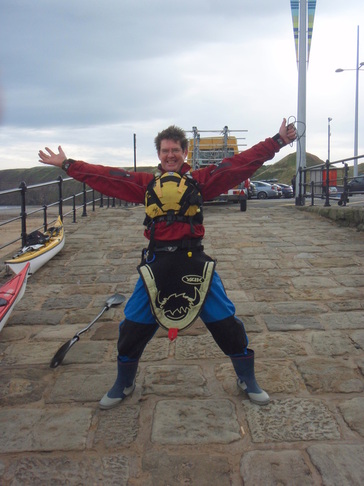Clothing
In all paddle sports it is important that clothing should protect the body without being too restrictive. There is a lot of expensive and technical kit on the market but there is
no real need to rush out and buy everything all at once. Spend a little time considering what you want to use the kit for – Sea-kayaking? Competition? Touring the canals? When you hope to be paddling – balmy summer days? or
through the winter with ice on your paddles? And whether your chosen kit will be adaptable to various conditions?
Essentials
Buoyancy aid -(available for hire from club to members )
Various types are available, some general purpose, others specifically for whitewater, sea-kayaking, competition etc. A buoyancy aid is probably the most important piece of safety kit you’ll invest in so don’t just rush out and buy the first one you see. Treat it with respect and it will last a long time.
Helmet – (available for hire from club to members )
Helmets are necessary for white water, shallow rivers, polo, slalom, river racing or surfing. Choose one which can be adjusted to fit your head so that it doesn’t slip back or forward, covers your forehead and has a strong chin strap. It should be made of a durable material and float. Helmets should be CE approved - CE1385.
Spraydeck –(available for hire from club to members )
The spray deck is an elasticated ‘skirt’ that prevents water from entering the kayak through the cockpit area. In rough water it is an essential item and in cold weather it helps keep you warm. The quick release strap must be accessible, in case of a capsize. Spray decks can be made of tough fabric (cheap but not 100% waterproof) or neoprene (expensive but more watertight. Also harder to release)
Different spraydecks fit different boats.
On top of these essentials whatever selection of kit you choose, it will probably be a variation on the insulating layer
plus waterproof/windproof layer theme.
CLOTHING
Clothing must give you thermal and physical protection without hindering your movement, particularly in the shoulders and torso.
1. An Insulating Layer –
Insulation can come from several thin layers rather
than one single thick layer. More dead air is trapped in and between thin layers than in one thick layer. A wetsuit can form part of this insulation, and so can synthetic thermals and fleeces.(not cotton!)
2. A Water/Windproof Shell Layer –
This is the crux of the system, ranging from waterproof (like a dry suit or dry cag) for white water to a light shell for competition or fair weather.
Warm Weather Paddling
Specialist canoe kit is not essential on warm summer days. To start off with, wear a pair of shorts, which dry quickly when damp, a T-shirt and some form of footwear. A lightweight or short shell top will combat any wind chill. You may want to invest in some neoprene shorts, beach shoes and a synthetic thermal top.
White Water Touring/ Playboating/Surfing
Base layer ‘thermal’ garments, worn on the torso and/or legs need to be thin, close fitting and comfortable. In colder conditions, an intermediate layer of ‘fibrepile’ or ‘fleece’ warms quickly by trapping air to provide a thermal barrier. If there is a chance of immersion, swimming or just cold winter days a Long John sleeveless wetsuit can be worn.
Wetsuits are buoyant and keep you warm if you get completely soaked. If you are sure that you won’t be falling in, a wetsuit is not essential. There are specially cut and shaped ‘paddling jackets’ – called ‘cags’ - made from
coated nylon or light breathable fabric, with close fitting wrist and neck seals to stop water penetration. There is a whole range of cags on the market from those
that keep just the splashes and wind off to the ’dry cag’ with latex and neoprene seals.’
In very cold conditions, and for expeditions to colder climes, the full ‘dry suit’, which seals the water completely out, is very much appreciated.
Choice of footwear is a matter of personal preference, but for white water or winter paddling, purpose made wet suit shoes/boots are ideal.
For the hands, the ‘Pogie’ or ‘Paddlemitt’ can be a very useful accessory.
Kayak and Canoe Touring
If it’s cold, dress as for white water paddling. Lots of light layers to trap air and regulate body temperature are important. Use a ‘base layer’ system and build on
this, as weather and water conditions dictate.
For canoe paddlers, a long style ‘shell’ jacket, which can be easily vented, is a sound investment. Keeping the head warm and keeping the sun out of your eyes are important factors.
And, for those hot summer days on the continent – back to the shorts and T-shirt.
Possible kit list for winter
Wetsuit (sleeveless)(not recommended for touring where likely to be worn for long periods) or dry trousers and thermal leggings
Thin thermal or warm fleece top (not cotton)
Wetsuit bootees(never paddle in bare feet)
Paddling Jacket (Cag)
The following clothing would be suitable:
Thermal vest(not cotton)
Light fleece
Tracksuit bottoms (not cotton)
Light water-proof bottoms
Trainers or beach shoes
Possible kit list for summer
Thermal vest,
light fleece,
synthetic top (such as a football strip)
Nylon tracksuit trousers
Trainers or beach shoes
Light-weight wind-proof/splash-proof top
Simply increase or decrease the layers until you feel comfortable.

Here we see John modeling his sea kayak touring combo, Dry cag in dark red with double seal for spray deck(in black and taupe), bouyancy aid in black and yellow with plenty of pockets for chocolate,compass and whistle, waterproof trousers in blue and black and finally short tight fit welly boots..... Not the usual, colour co-ordinated outfit for you John..must have been an OFF day
